SEARCH






|
|
|
|


by Yan Zhang
The man who has been my companion in the mountains
After I completed a mountaineering training course in January 2014, I started to prepare for serious alpine expeditions, in order to fulfill my ambition of making grand landscape photographs of the Southern Alps in New Zealand.
I understood that having a reliable mountain companion was a key to my plan, for which I had got in touch with many individual mountaineers, as well as various mountain clubs in New Zealand for several months. Then Mark Watson came to my attention.
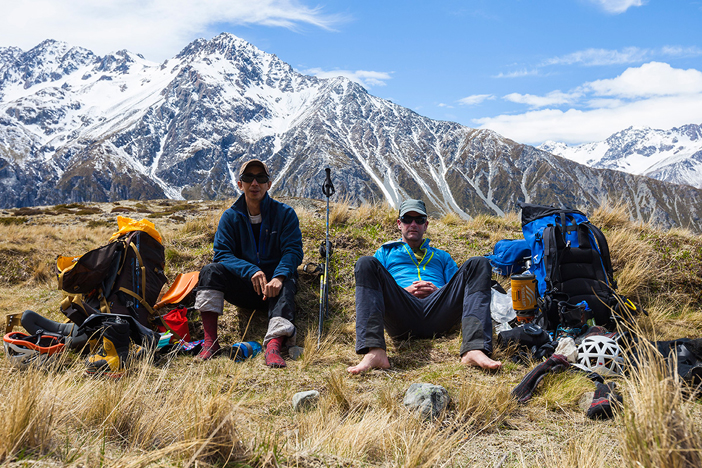 Mark Watson (on the right) and Yan Zhang - They completed their Ball Ridge climb together in November 2014
Mark Watson (on the right) and Yan Zhang - They completed their Ball Ridge climb together in November 2014
Adventure is Mark’s lifestyle
Mark is an experienced mountaineer who started his mountaineering activities at a very young age, and has climbed many peaks in the New Zealand mountains, both in the South and North Islands as well as overseas. At the same time, Mark is also an adventure photographer. Over the years,his photographs have faithfully capture his adventure journeys, and have appeared in many books, articles and on magazine covers.
Since Mark and I have teamed up together in mid 2014, we have climbed several mountain regions in the Southern Alps and he has become a companion for my mountain adventures. From Mark, I have learned many practical mountaineering skills, sometimes in difficult situations. During our journeys, we have explored mountain scenery together, but with different viewpoints; we exchanged our photography ideas; and we shared the hardship and happiness we gained from our mountain trips. In the last two years, our trust and friendship have been tightly established through our passion for the mountains.
We share a common view on mountain photography
As described in Tasker and Bonington’s book, the mountains are a savage arena. Everyone who has climbed in alpine regions can perceive the potential danger there anytime. Every time I have been in the mountains, I have inevitably felt the power of nature, and was aware of how insignificant we were.
This experience is completely contrary to those gorgeous mountain pictures made by other photographers, in which a man has intentionally become a dominating subject against the vast mountainous surroundings.
I can only say that such images lack a kind of authenticity. I believe in the pioneer adventure photographer and explorer Galen Rowell’s principle: we should faithfully illustrate the beauty of mountains. For Mark and I, it has been our common goal to capture the unique aesthetics, authenticity and genuineness of the New Zealand mountain landscapes, through our personal visions.
In this interview Mark will share with us his vision, stories, and journeys in adventure photography. I hope our 1X readers will enjoy this interview, as well as his impressive photographs.
Hi Mark, I am very glad that you have accept the invitation by 1X Photography to have this interview with me. I believe your unique experience in New Zealand’s mountains and wilderness will bring us to a very fresh and different perspective on New Zealand.
Firstly can you please tell us a bit about yourself? For instance, when did you start your mountaineering activities? When did you begin to be a hard core outdoor and mountain photographer?
Thank you Yan for the opportunity to be interviewed for 1X. It is an honour and I’m thrilled to be able to share my experience of photography with your audience.
I started climbing as a teenager. I had been raised by parents who were very active hikers, so climbing seemed a natural extension of that. At that time it was the thrill, the perceived risk and the sense of accomplishment that drove me to want to climb all the time. However as time went by, I came to realise that climbing skills provided another means to experience a great range of outdoor experiences: the ability to move confidently over all sorts of terrain, to be able to find routes and manage your risk and to have a different perception of the outdoors.
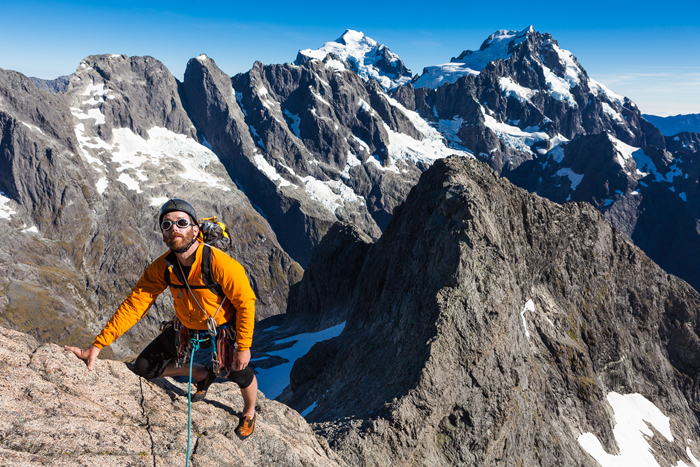 Rock Ridge – My companion Tom Riley on the seldom climbed North Ridge of Te Wera,
Rock Ridge – My companion Tom Riley on the seldom climbed North Ridge of Te Wera,
Central Darran Mountains, Fiordland, New Zealand.
Most of my climbing has been on rock, including alpine rock climbing, but over the years for mountain adventures and to climb on ice, I have made many trips into the Southern Alps. For many years I have been an absolutely obsessed climber. I still love it, but more recently I have found that other passions (notably photography) have interrupted my flow with climbing.
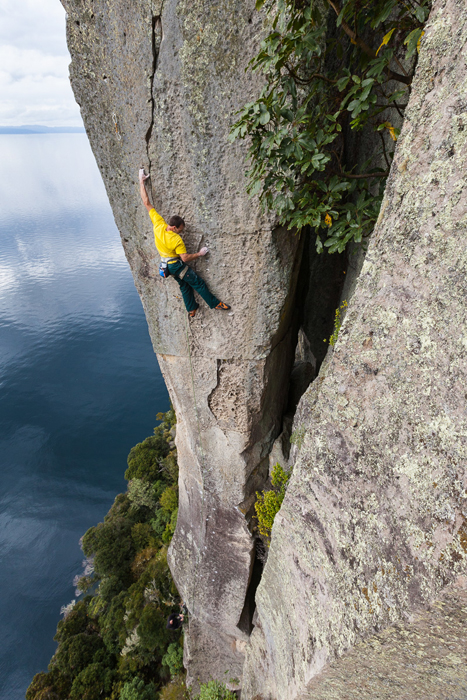 Zen –Rock Climber Tom Hoyle climbs the Tibia Pinnacle,
Zen –Rock Climber Tom Hoyle climbs the Tibia Pinnacle,
Whanganui Bay, Lake Taupo, New Zealand
Photography came later, about the year 2000, when I decided to take a night class to learn basic photography, and a year of overseas travel and climbing subsequently gave me a chance to dabble and experiment with what I had learned.
From 2002 to 2009 I worked for the New Zealand Alpine Club as editor and designer for their magazines, books, including guidebooks. I was climbing very actively at that time too. There was a demand for more photographic content for the magazine and images to illustrate stories, but we had no budget to pay a photographer so I decided to tackle assignments myself. On my mountain trips I had already started carrying a camera with me more often and had started to hone my composition and technique. I was immediately hooked with the challenge and satisfaction of climbing photography – the thrill of seeing a perfectly exposed climbing moment captured on film; vibrant and detailed on my lightbox at work. From there on I began to shoot more and more, but usually alpine/outdoor activity and rock climbing. I didn’t begin with serious landscape photography until 2012.
I understand that you have published two books. I have read your first book Our Mountains twice. Now this book has become one of my primary New Zealand mountain references – it is not only illustrated with many beautiful mountain photographs, but also contains a lot of useful mountaineering information that other mountain books lack.
Would you like to share with us why you wanted to produce such a book and how you and your co-author completed this book?
The general idea for Our Mountains came from the co-author Paul Hersey who invited me to collaborate with him on a project. Paul was already an established author, with three books under his belt. I was returning to New Zealand from three years of climbing and cycling adventures in the Americas, UK and Asia and Paul invited me to work with him. The product that manifested started from a basic idea and evolved as we discussed and worked on it. It wasn’t until we had worked on the first couple of mountains, that we really nailed the purpose and message of the book down.
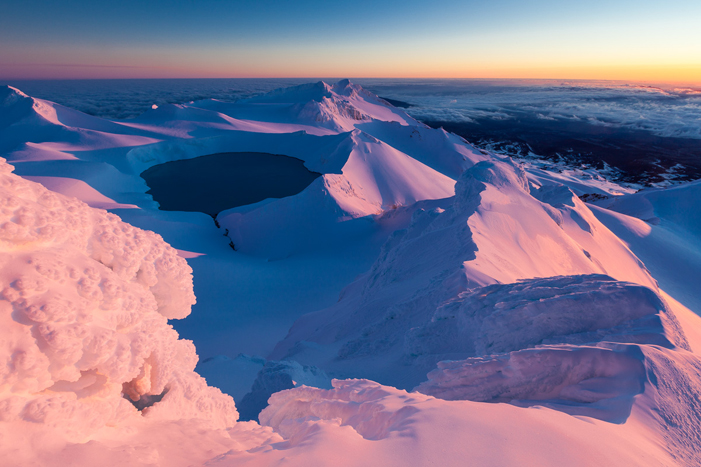 Crater Lake – the Crater Lake and summit plateau of Mount Ruapehu,
Crater Lake – the Crater Lake and summit plateau of Mount Ruapehu,
the North Island of New Zealand's highest mountain at 2797m.
Our Mountains celebrates 15 New Zealand mountains which are the most notable for each of New Zealand’s major regions. We wanted to represent New Zealand as a whole, with the a big geographic spread, given that those are not all high mountains – for example Auckland’s characteristic mountain is Mount Eden, with only 196 meters!
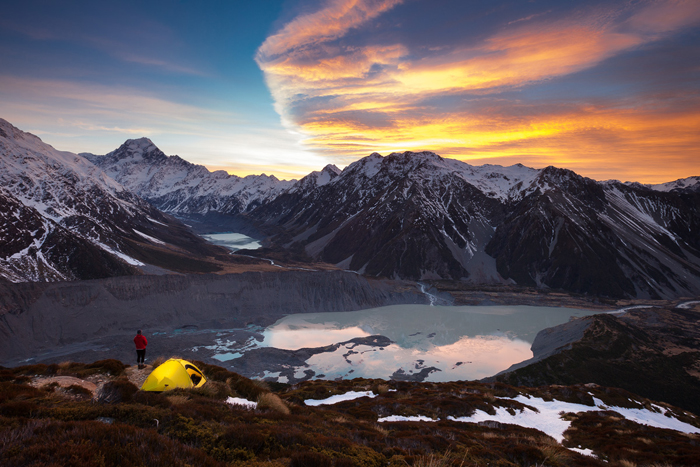 Aoraki Sunrise – Winter camp at Sealy Tarns overlooking Hooker Valley, Mueller Lake,
Aoraki Sunrise – Winter camp at Sealy Tarns overlooking Hooker Valley, Mueller Lake,
Mt Wakefield and Aoraki Mount Cook. Cover shot from Our Mountains.
Paul wrote about his own experiences with these mountains, and stories about people who are associated with or live beneath them. Over a 15 month period, I climbed or hiked to the summits of all of them, sometimes making repeat visits, to capture the photographs we would need for the book. It was a very satisfying project to work on, both in terms of physical accomplishment and creatively. But it was also extremely challenging, as I generally had to work with the conditions I had on the day in any given place.
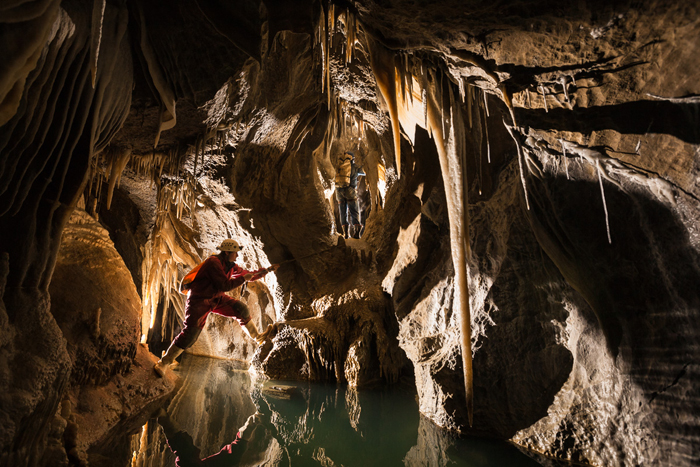 Oubliette Sector – Pioneering caver Neil Silverwood in the Oubliette sector of the Nettlebed Cave system.
Oubliette Sector – Pioneering caver Neil Silverwood in the Oubliette sector of the Nettlebed Cave system.
Kahurangi National Park, New Zealand.
Now let’s focus a bit on your photography. With your expertise in the mountains and wilderness, I noted that many of your photographs are actually telling a story – a commonality shared with the works of other adventurous photographers such as Galen Rowell and Jimmy Chin..
Among these other story-telling photographs, do you have your favourite shots? Can you pick up one and tell us the story behind it?
Thanks Yan. Yes, I believe that for most images to be successful, they need to express the photographer’s intent and communicate something about the subject or situation – to have a tangibility about them – to have a deeper connection with the viewer. This is often a difficult thing to achieve. Skilful composition and unique moments of light or subject all contribute to special and lasting imagery. There is a huge amount of ‘eye-candy’ imagery circulating these days and while this style of photograph is popular, I think much of what passes for landscape photography today will not be enduring. I see viewers getting tired of saturated, explosive sunsets and postcard compositions.
The image I have chosen (see next photo below) is that of a friend alone in a mountain scape in the Central Darran Mountains in New Zealand. We were en-route to a remote lake and had to climb over a mountain to get to where we were in this image. The weather had been unsettled all day — it had been snowing earlier and the rocks had been plastered with ice. Often when I photograph people in the mountains, I look for a composition or scenery that would make for a good image even without the human element, but adding the person at the right place can further create drama, scale and storytelling. It also connects the viewer more emotionally to the photograph.
In this case I deliberately separated myself from Tom, so he would appear smaller as I photographed, while walking down the rock slabs. Anticipation is important, and I could see Tom would be skylined against the snow as he walked. I shot several images, but liked this one best, because of the moment and sense of purpose implied by the walker. The complex mountain light and cloud adds drama and depth.
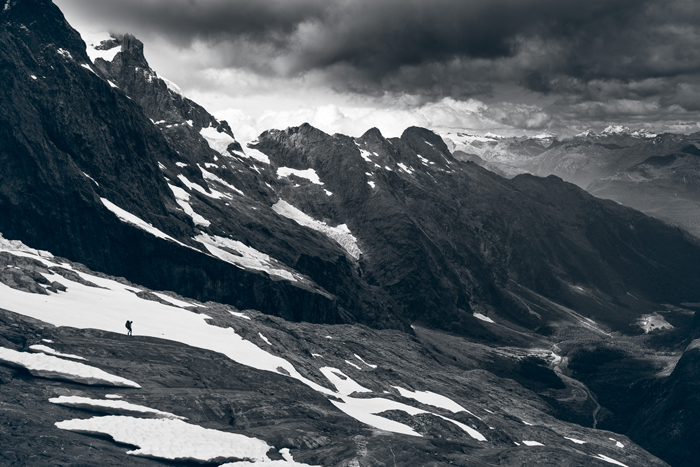 Cleft Creek –Tom Riley above Cleft Creek en route to Lake Turner. Central Darran Mountains,
Cleft Creek –Tom Riley above Cleft Creek en route to Lake Turner. Central Darran Mountains,
Fiordland National Park, New Zealand.
While many of your photographs embed a mood of the remoteness of nature in the mountains, they are also reflecting on the true relationship between men and nature, which, as I already mentioned in my earlier introduction, is missing from some other photographers’ works.
As a serious climber and outdoors person, how does your photography distinguish itself from others?
I suppose I acknowledge that I can get to places on foot that many other people can’t! That helps, but also I make the effort to carry my equipment to nearly every place I go in the outdoors, recognising that in some cases no, or few, other people might have made photographs in these places. As mentioned I often attach a human element, but I also strive to exclude man-made elements from my photography. Huts are sometimes featured, but generally I seek to express the unique and fragile natural landscape and wilderness of New Zealand – to communicate to others the real depth of this country and to make people aware of the incredible back country we have out there.
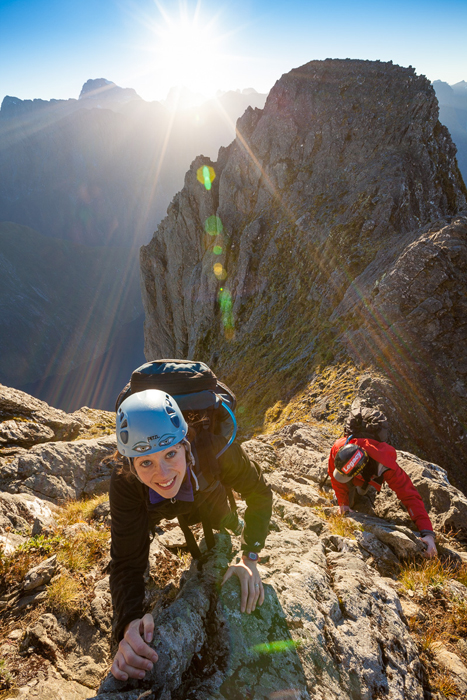 Descent from Mitre – Liam and Jo Dangerfield down climbing just below the summit of Mitre Peak.
Descent from Mitre – Liam and Jo Dangerfield down climbing just below the summit of Mitre Peak.
The climb was made to shoot photos for the book Our Mountains. The climb took the whole day,
then we bivouaced on the summit in perfect warm and windless conditions and descended the next day.
I also hope to inspire people to be active – to see the hills for themselves and experience some of the joy and primal connection with Earth and natural phenomena that can only come from time spent outdoors in wild places.
Now I’d like to get back to some mountaineering questions. As you know, I am getting more and more serious about exploring New Zealand’s alpine mountains and taking good photographs there. People, who have seen my photographs made in the Southern Alps, keep asking me how to climb those mountains with all the necessary camera gear.
I think our audience might be interested to hear from you about what the essential mountaineering skills are that one needs, in order to make serious photographs in the mountains. May you please share with us your thoughts and experience on this?
Basic outdoor competence is the starting point for remote and wilderness photography, and specialist skills come on top of that. Knowing how to pack a backpack, how to camp, what to leave behind, how to save weight and how to be self reliant and minimalist are all skills that come from time spent outdoors. Route finding, navigation and weather/hazard assessment skills are essential too. Building on that, mountain photography requires basic competence with ice axe and crampons, and sometimes basic rope work if venturing into technical or exposed terrain.
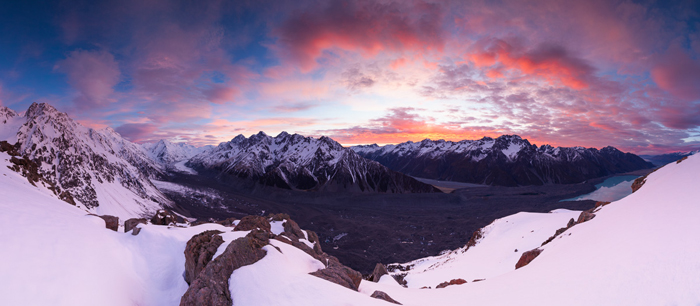 Southern Alps – Panorama encompassing the view from Cinerama Col (Aoraki Mount Cook) through to
Southern Alps – Panorama encompassing the view from Cinerama Col (Aoraki Mount Cook) through to
Tasman Glacier Terminal Lake, looking east at sunrise. Range just left of centre is Malte Brun Range,
with Liebig Range/Burnett Mountains on right. The 27km long Tasman Glacier runs through center of photo.
This photo was taken during a mountain trip with Yan Zhang.
While mentoring from experienced climbers is a good way to learn, a professional course is the best way to fast track your skills and knowledge-base. These can be done with guiding companies or through the NZ Alpine Club. There is no substitute for experience though – and this is gained by spending as much time in the hills as possible. Careful research is important for those venturing into new areas for the first time: read guidebooks, talk to local authorities (i.e. Department of Conservation) and get an idea of what you are in for. Mountain photography is quite different to a usual hiking trip, as your backpack will be heavier so fitness and extra walking time is required for this.
I believe that having photographs published is every photographer’s desire. In this aspect, you are quite successful – a number of your photographs have been selected as cover pages for well-known photography and outdoor magazines including the recent cover page photo for "Australian Geographic Outdoor".
What are your criteria for a good photograph? How do you meet these criteria in practice?
In the case of magazine covers, there is a degree of paradox involved as what works to sell magazines is not always what I like to shoot! Magazines often prefer images that are a little staged, in order to achieve the ‘right’ look and situation and this is not really my favourite style of photography. Of course it’s very satisfying to see my images on covers, but I generally prefer images where the circumstances are entirely natural, or at least no more than saying to my partner ‘stop there for a moment’. For myself, I aspire to shoot imagery that is not too forced, that has a realness to it and that has the ability to elicit a response from the viewer, but that has to come from the photographer’s stimulus and response to the circumstance or light that they experience. It all comes down to moment, light and composition – which encourages emotion.
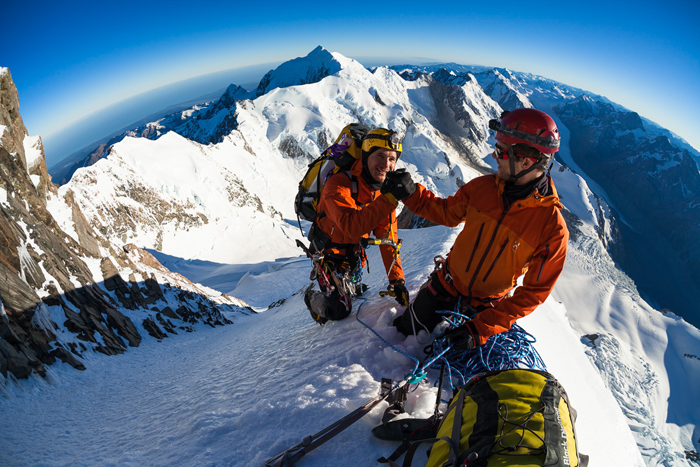 Handshake – Two mountaineers/paragliders just below the Summit Rocks of Aoraki Mount Cook.
Handshake – Two mountaineers/paragliders just below the Summit Rocks of Aoraki Mount Cook.
Later that morning they both flew from the summit. This photo strongly represents the teamwork
and camaraderie common with mountaineering partnerships.
I believe that the more you shoot, the more you ‘see’, you develop an acute awareness of light, and also the ability to anticipate. Patience and self- discipline is essential. I guess one measure of success is that the photograph makes the viewer want to be in the same location himself/herself or to have the same experience, or at least raises curiosity.
As a sole author, I know that you recently published your second book Te Araroa. I have just read this book. I think it is remarkable – not just because it contains unique photographs taken at places that have not had much exposure, but more incredibly, they’re from a 3000km journey completed in 6 months.
May you explain what inspired you to set up this big project on walking the 3000 km Te Araroa trail?
The Te Araroa trail is New Zealand’s long distance hiking trail and it traverses the country from end to end. It’s New Zealand’s version of the Appalacian or Pacific Crest Trails in the USA, and covers an incredible diversity of terrain en route. The trail is slowly growing in popularity, with about 200 through-hikers completing it the same season I walked it. It’s special for the fact that it encompasses forest ranges, rural land, towns, cities and coastline – a bit of everything really. I wanted to experience what the trail was about for myself, while creating a photographic expression of the landscapes and terrain that it covers.
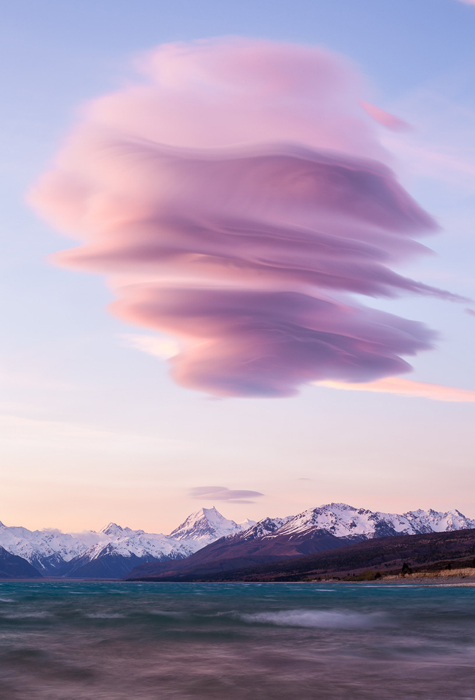 Nor-Wester –Lenticular wind cloud formed over Lake Pukaki, Aoraki Mount Cook
Nor-Wester –Lenticular wind cloud formed over Lake Pukaki, Aoraki Mount Cook
and the Southern Alps. Canterbury, New Zealand.
I set out from Cape Reinga in January carrying several days supply of food and 8 kg of camera equipment. I had a good idea of some of the scenic highlights of the trail, but I was not prepared for how much I would learn about New Zealand while on the walk. My journey became a constant photographic response to what I witnessed around me as I walked, and every day on the trail I sought to express, in the best way I could, the salient aspects of each section. It was total immersion photography and was incredibly satisfying, quite aside from the physical satisfaction (and exhaustion!) of walking 8–12 hours every day.
I think setting up such a photography project would need a lot of preparations and planning. When you executed this plan, there must have been many difficulties and obstacles you had to overcome, both physically and mentally.
Would you like to share with us some details on these issues coming up during your long journey on the Te Araroa trail?
I knew I had put upon my shoulders a big challenge with this project. I had a contract with a publisher before I started, so I had to do it, and had to produce consistent results. The only way to achieve this was through total commitment to the process. When it comes to my passions, I can be very self disciplined and I applied this discipline throughout: to wake well before sunrise each day, in order to be positioned to shoot. I planned as much as possible, or predicted what the subjects might be ahead of time so that I’d be in the right place for light. This sometimes meant half of a day might be committed to a particular place or image, but at other times, I could do nothing but go with the flow, and rely on my ability to respond, compose and story tell when the light was right.
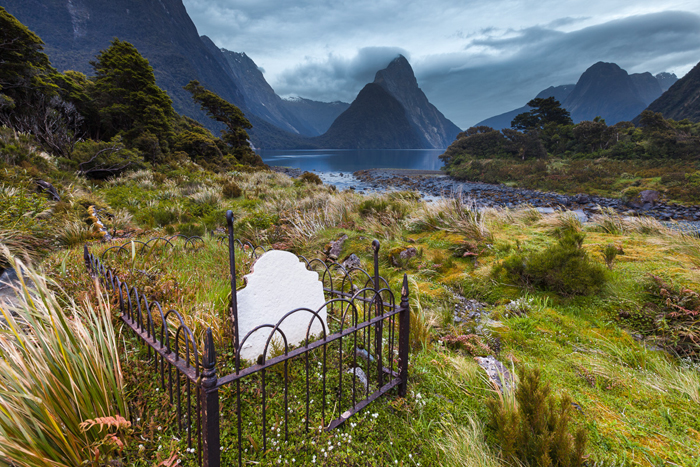 A Lonely Grave – William Rathbun's lonely grave lies in the wind blasted flats below Bowen Falls,
A Lonely Grave – William Rathbun's lonely grave lies in the wind blasted flats below Bowen Falls,
Milford Sound/Piopiotahi, Fiordland National Park, New Zealand.
One of the biggest challenges, creatively, was that I’d see most of the trail places only once and each and every day, I had to work with the conditions and light that I had. The upside of this is that it imparts an honesty in the images: they’re contiguous and representative of the experience a trail walker has; the changing light, and good and bad weather.
Because I started very late in the normal trail season I walked through autumn and winter and experienced very cold conditions and sometimes some big snowstorms. My mountain experience gave me the confidence to deal with these situations though and I actually relished the additional challenge. The different seasons added a bit more to the range of imagery too. I was very lucky to have had the assistance of my partner Hana Black and she walked 900 km of the trail with me, and helped with logistics along the way.
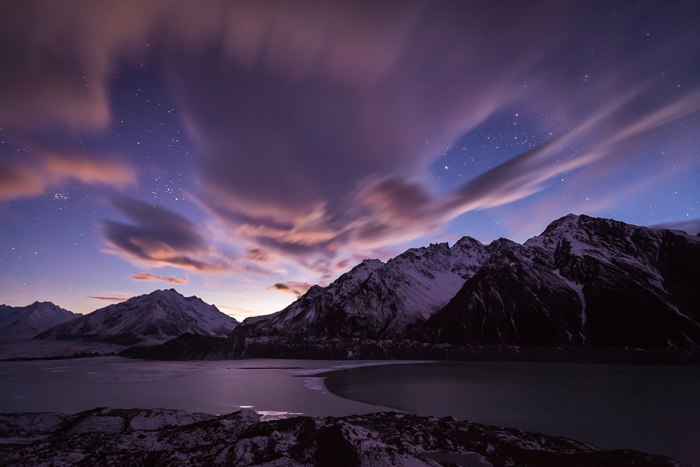 Space/Time – That moment when dawn's first glow starts in the eastern sky, but the night's stars have yet to fully fade.
Space/Time – That moment when dawn's first glow starts in the eastern sky, but the night's stars have yet to fully fade.
Shot overlooking the Tasman Glacier terminal lake (half frozen on a winter's night),
Aoraki Mount Cook National Park, New Zealand.
As a photographer as well as a mountaineer and adventurer, I think you have defined your unique photography style and position. May you tell us what your next project will be? What are the goals you want to achieve in the near future?
In June of this year I’m going to start a bicycle journey together with Hana, spanning the full length of the Americas; an expedition we have been planning for two years. We’ll start from Prudhoe Bay in Alaska and plan to ride to Ushuaia, Argentina, taking off-road options and riding in remote and mountainous regions as much as possible. For example, we’ll be riding the length of the USA following the Great Divide Trail, which avoids sealed roads and crosses many passes.
We’re planning for at least two years, and I’ll be documenting the ride for a photography book about the landscapes, cultures and experiences throughout the journey. It should be quite a ride!
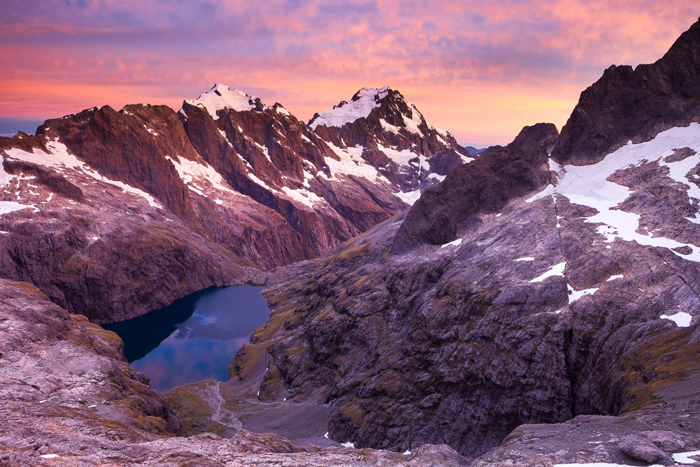 Lake Turner Sunrise – Sunrise over the Central Darran Mountains and Lake Turner. Fiordland, New Zealand.
Lake Turner Sunrise – Sunrise over the Central Darran Mountains and Lake Turner. Fiordland, New Zealand.
Thank you very much, Mark. I really appreciate that you share so much about your mountain and wilderness photography journey with us. I wish you the best for your continued journey of adventure.
Mark Watson’s photography website
 | Write |
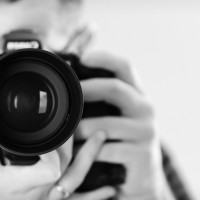 | Graham Daly Great article and lovely images. |
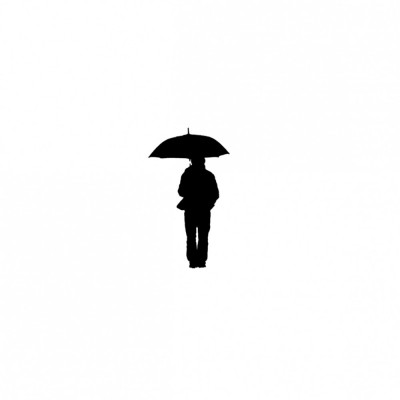 | Massimo Della Latta Splendide.
|
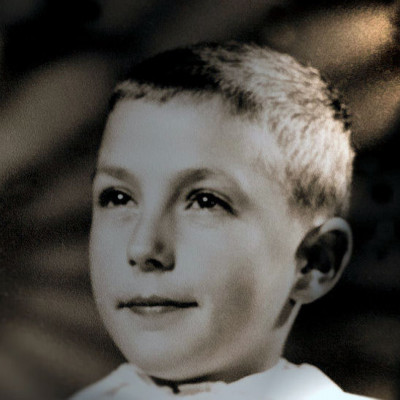 | Thierry Dufour PRO Magnificent interview and fantastic images, thank Yan and congrats to Mark Watson !!! |
 | Mohammad Soheilinia Mountaineering, rock climbing and caving professional sports is very hard and expensive equipment to limit the risk of death at any moment one of the three disciplines, so photography is very difficult and dangerous,Thank you for sharing with us the magical moments of extreme and Grateful Yvette for the attention given to the viewer and reader.
|
 | Yvette Depaepe CREW Captivating and most interesting interview!!! Thanks a lot for conduction this photostory and interview, Yan. My respect and admiration for Mark Watson!!! |